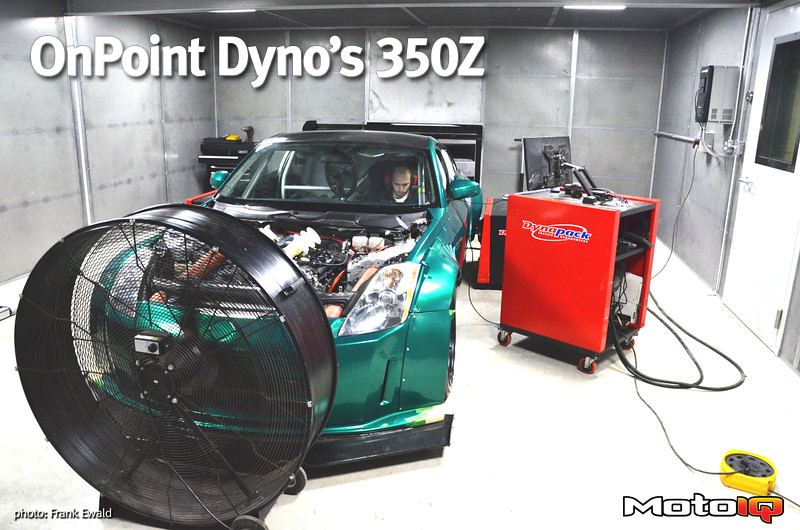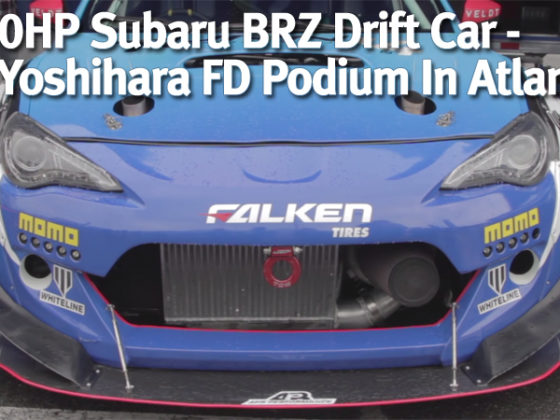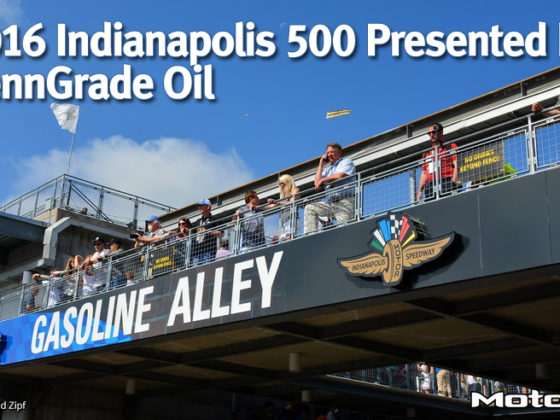,
 I followed Sasha, Trevor, and the car from the workshop to a nearby dyno cell. Sasha's dyno service, OnPoint Dyno, is completely mobile and he travels across the greater Toronto area. Here Sasha is making some last minute adjustments with the throttle cable prior to hooking up the car to his DynaPack Hub dyno.
I followed Sasha, Trevor, and the car from the workshop to a nearby dyno cell. Sasha's dyno service, OnPoint Dyno, is completely mobile and he travels across the greater Toronto area. Here Sasha is making some last minute adjustments with the throttle cable prior to hooking up the car to his DynaPack Hub dyno. For 2016 this 350Z is wide as both wheels, tires, and body panels have been changed. The wheels are 18×12 Volk Racing ZE40s shod with 325 660 18 Pirelli slicks. They are contained by Rocket Bunny front over fenders. The Nismo V1 replica front bumper was extended by Sasha and Kevin Stittle (a racing buddy with a creative flair) to match up with the wider stance that the Rocket Bunny fenders provided. Kevin also added 6″ to the splitter to account for the wider stance. Nismo V1 replica side skirts are going to be installed on the car shortly.
For 2016 this 350Z is wide as both wheels, tires, and body panels have been changed. The wheels are 18×12 Volk Racing ZE40s shod with 325 660 18 Pirelli slicks. They are contained by Rocket Bunny front over fenders. The Nismo V1 replica front bumper was extended by Sasha and Kevin Stittle (a racing buddy with a creative flair) to match up with the wider stance that the Rocket Bunny fenders provided. Kevin also added 6″ to the splitter to account for the wider stance. Nismo V1 replica side skirts are going to be installed on the car shortly. The rear over fenders are from Crown Crafting in California. Sasha likes how they tie in with the stock bumper.
The rear over fenders are from Crown Crafting in California. Sasha likes how they tie in with the stock bumper. You can see the additional width that was required to bring the splitter out to match the Rocket Bunny fenders. The overall width is 100mm (about 4″) greater than a stock 350Z.
You can see the additional width that was required to bring the splitter out to match the Rocket Bunny fenders. The overall width is 100mm (about 4″) greater than a stock 350Z. The rear wing is from DJ Engineering and as you can see it has two flaps. The front flap is currently running at zero degrees and usually left fixed, with the rear element being used for adjustments and fine tuning at the track. The wing mounts go through the trunk to the frame. DJ Engineering's wings can be found on a lot of hill climb and formula cars.
The rear wing is from DJ Engineering and as you can see it has two flaps. The front flap is currently running at zero degrees and usually left fixed, with the rear element being used for adjustments and fine tuning at the track. The wing mounts go through the trunk to the frame. DJ Engineering's wings can be found on a lot of hill climb and formula cars. Sasha and Kevin built the carbon doors and roof. The trunk lid is a Seibon carbon unit and the rear window is lexan. The car weighs about 2690 pounds dry.
Sasha and Kevin built the carbon doors and roof. The trunk lid is a Seibon carbon unit and the rear window is lexan. The car weighs about 2690 pounds dry.The trunk area contains the Fuel Safe racing cell that was installed in the car in 2003. The foam has been updated, however, nothing else has been changed because it is a well designed unit. It has a Bosch 044 fuel pump with two Facet lift pumps feeding a swirl pot that is inside the fuel cell. The swirl pot is like a bucket, in that the lift pumps fill it up and when it is full the fuel just sloshes over the edges and back into the mix of fuel in the cell. A second advantage is that the fuel in the cell cools the swirl pot – whereas swirl pots that are positioned outside of the tank/cell have a tendancy to heat up. Finally, the fuel cell is located in the OEM fuel tank location which provides for great centre of gravity and reduced polar moment relative to a rear mounted fuel cell. All in all, sounds like a great idea. Just in case this Nissan 350Z goes endurance racing, there are dual dry break fueling ports through the trunk.



